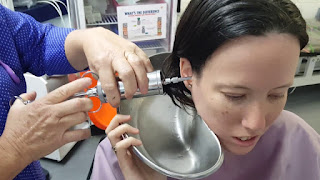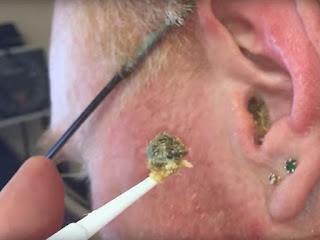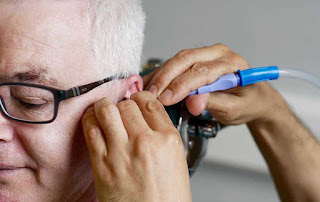EAR WAX
An existing hearing loss can be exacerbated by the presence of
ear wax. Ear wax can significantly reduce the transmission of sound by blocking
the ear canal, blocking the sound
from exiting the hearing aid, or causing damage to internal components
of the hearing aid.
What Is Ear Wax?
Ear wax is a normal product of the ear. Ear wax is primarily composed
of keratin (dead skin) with a mixture of cerumen, sweat, dust, and other
debris. The amount and consistency of ear wax vary from person to person. Ear
wax can vary in color from yellow to orange or reddish-brown to dark brown or
almost black. It may be nearly liquid or thick, sticky or dry, or soft or hard.
Wax type is genetically inherited, although the appearance of wax may vary from
time to time in the same person. Cerumen type has been used by anthropologists
to track human migratory patterns, such as those of the Inuit. There are two
main types, wet and dry. Dry flaky wax is common in persons of Asian descent
and Native Americans. Dry wax contains by weight about 20% lipid. Wet wax is
common in people of Western European descent (Caucasians) and people of African
descent. Wet wax can be either soft or hard, with hard wax being more likely to
be impacted.
Why Do We Have Ear Wax?
Various hypotheses have been advanced as to the purpose of ear
wax. It has been proposed that wax provides protection against foreign objects,
assists in cleaning the ear canal, acts as a lubricant, acts as an
antibacterial and antifungal agent, and promotes a healthy immune response. Debris
is removed from the ear canal by a “conveyor belt” process of epithelial
migration that is aided by jaw movement. Cells of the tympanic membrane migrate
outward from the umbo to the walls of the ear canal. The speed of cell
migration accelerates as the cells move outward to the entrance of the ear
canal. The cerumen in the canal is also carried outward, taking with it any
dirt, dust, and particulate matter that may have gathered in the canal.
Wax can also act as a lubricant, preventing drying and itching
of the skin in the ear canal (asteatosis). In wet-type cerumen, the lubricating
effect is due to the presence of cholesterol, squalene, long-chain fatty acids,
and alcohols produced by the sebaceous glands. Cerumen can provide protection against
some strains of bacteria.
Removal of Ear Wax
If wax is hard and impacted in the ear canal, it may cause damage
to the skin as it is removed and thus should be first softened. Wax removal is
often more difficult for older people because their wax tends to be drier and
harder. Ear wax can be softened by applying a few drops of mineral oil, baby oil,
or glycerin in the ear for several days in a row. Oil should
be administered at night time so that it can be absorbed into
the wax and skin overnight. If oil is administered in the morning, the oil will
likely get into the hearing aid when inserted and possibly disable the hearing
aid.
SYRINGING
WITH WATER
Syringing with water can be done by a client at home, by a
trained audiologist, by a family doctor, or by another qualified person. Water
pressure may, however, push the wax deeper into the canal (possibly touching
the eardrum), whereas significant amounts of water may remain in the ear canal
after syringing. When hydrogen peroxide (H2O2) is used,
oxygen bubbles off, leaving water in the ear canal. A problem with wet, warm
ear canals is that they make good incubators for growth of bacteria. In these
instances, the ear canal may be flushed with isopropyl alcohol to displace the water
and dry the skin but should be used sparingly to avoid excessive drying and
itching.
PLASTIC
SCOOPS
Small, flexible plastic scoops are commonly used by
audiologists trained in wax removal. A good hands-free magnifier and light
source are required. The basic technique is to gently scoop built-up wax from
the canal. Care must be taken to minimize discomfort or trauma to the ear canal
and to avoid contact with the tympanic membrane. This method is not recommended
if wax is deeply impacted. Hairs in the ear canal may be embedded in the wax
and can leave small amounts of blood in the canal when they are pulled out with
the wax.
SUCTION
Suction is an effective way to remove wax and debris; however, there
is a risk of damage to the ear canal and/or tympanic membrane. This method can
be uncomfortable for the client, both physically because of the suction and
acoustically because of the high SPLs. Suction should be used only by a
qualified practitioner such as an otolaryngologist.
COTTON
SWABS
Using cotton swabs to clean the ears is not recommended. Swabs
tend to push wax deeper in the canal and may stimulate the production of more
wax. Swabs irritate the skin of the ear canal and may damage the ear drum.
EAR
CANDLING
Ear candling or coning is an ineffective and potentially dangerous
method of cleaning the ears. A hollow candle is placed at the entrance of the
ear canal and lit, supposedly sucking out ear wax. Despite many claims that ear
candling is effective for wax removal, it has been proven that the substances
appearing within the cone originate from the melted candle, not from the ears.
The suction supposedly created by the candle’s flame is insufficient to remove
wax and there is a substantial risk of burns, infection, obstruction of the ear
canal, and perforation of the eardrum. Ear candling is not recommended at any
time, and federal health warnings have been issued.
Cleaning Hearing Aids
Hearing aids should be cleaned regularly as a preventive measure.
A thorough cleaning every 6 months is usually sufficient to reduce repairs due
to wax damage. Some clients require deep cleaning of their hearing aids every
month or even more frequently, whereas others may never have a problem with
wax.
A vacuum chamber with a suction tip for cleaning hearing aids
is essential for any hearing care practice. The vacuum chamber loosens and removes
small particles of dust and wax, whereas the suction tip removes more
recalcitrant debris. Care must be used when using a suction tip because the
receiver can be easily damaged.
Prevention: The Use of Wax Guards Wax guards are the first line of defense against wax damage in
a hearing aid. Different kinds of wax guards have been developed, including
covers, metal springs, vented plastic plugs, and vented plastic baskets. One of
the most effective is the vented plastic basket type, which is also the simplest
for clients to change on their own. When clients cannot change the wax guard
themselves, encourage them to bring their hearing aids in for regular cleaning
and to change the wax guards.








No comments:
Post a Comment